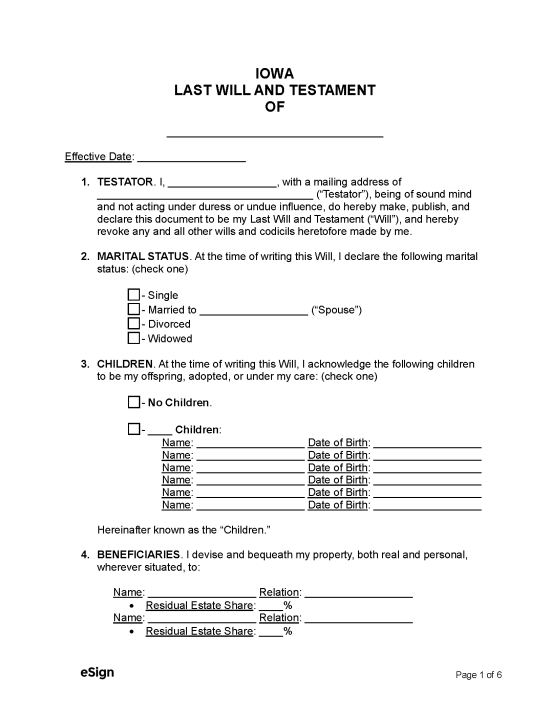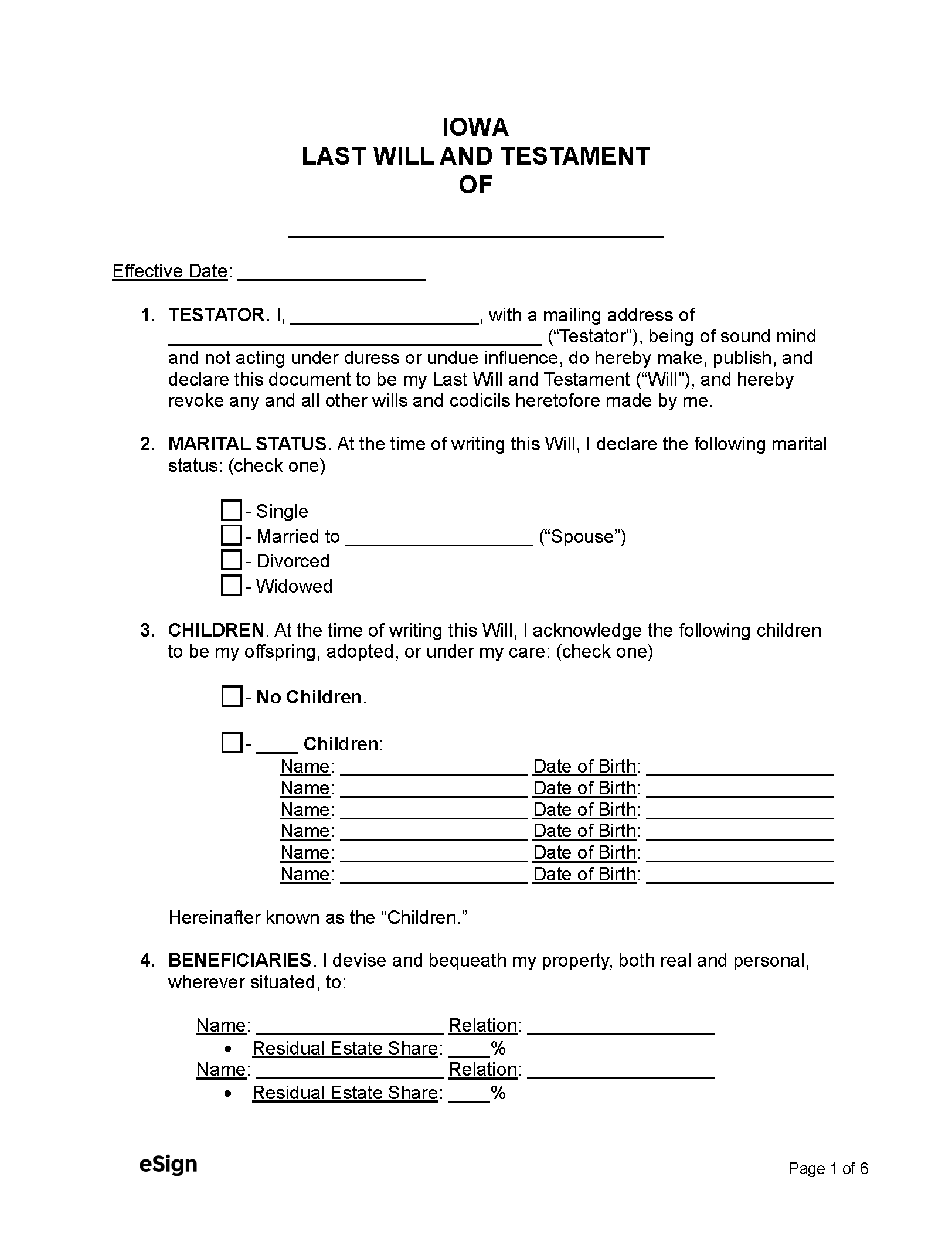State Laws
Any person 18 years of age and of sound mind may dispose of their property by will.[1]
Holographic Wills – Holographic (handwritten) wills are generally not accepted in the state of Iowa unless they meet all the other legal requirements outlined in the signing requirements below.
Revocation – A will can be revoked by cancellation, purposeful destruction, or the creation of a new document. The cancellation of a will must be done in the same manner as the execution of a will.[2]
Signing Requirements – A will must be signed by the testator and two witnesses at least 16 years of age.[3][4] A witness can be an interested party to the will, but any gift bestowed to them through the will may be void.[5]
Probate Process in Iowa (8 Steps)
- Small Estate Affidavit (If Applicable)
- Locate Will
- Small Estate Administration
- Petition for Small Estate
- Notice of Probate
- Report and Inventory
- Final Accounting
- Closing Statement and Distribution
1. Small Estate Affidavit (If Applicable)
If the testator’s estate has $50,000 or less in total asset value and no real property (besides right of survivorship; e.g., a shared home with a spouse), their estate may be distributed outside of probate using an Affidavit for Distribution of Property.[6]
A successor of the testator may receive assets using this method as long as 40 days have passed since the decedent’s death. They must provide the affidavit and a copy of the will and death certificate to the holders of said assets to initiate a transfer.
2. Locate Will
After the testator’s death, the original will document must be located and delivered to the court in the county where the estate is to be administered.[7] The testator typically leaves instructions with a family member or trusted individual as to the location of the will. It may be that the testator has already deposited the will with the court clerk during their lifetime.
3. Small Estate Administration
If the testator’s estate does not qualify for distribution via a small estate affidavit (Step 1), it may qualify for small estate administration which is more streamlined than the full probate process. The subsequent steps all pertain to the administration of a small estate.
In order to administer the state using this method, the value of a decedent’s estate cannot exceed $200,000.[8] When calculating the value of the estate, property that does not need to go through probate will not count toward the total. The following are examples of types of property exempt from probate:
- Joint tenancy property – This is property that is owned by the testator and other individuals; e.g., a home owned by the testator and their spouse.
- Living trust assets – Any property contained in a living trust that has a named beneficiary will be transferred upon the testator’s death outside of probate.
- Life insurance policies – If the testator had life insurance with named beneficiaries, the money within the policy is a non-probate asset.
- Retirement and payable-on-death accounts – Certain bank accounts, investment accounts, and retirement savings plans can be automatically transferred to named beneficiaries when the testator dies.
4. Petition for Small Estate
The personal representative named in the will (or selected by the testator’s heirs if they did not appoint one) must file a Petition for Small Estate Administration with the district court in the county where the decedent died. There are no state-prescribed probate forms for the state of Iowa, but the statutes set forth what must be included in the petition.[9]
In addition to the Petition, the personal representative must also complete and file a Court Officer’s Oath to confirm they acknowledge and understand their duties. If an attorney is used throughout the probate process (which is recommended), a Designation of Attorney form must also be filed.
Once the forms have been filed and approved, the court clerk will provide the personal representative with Letters of Administration which authorize them to act on behalf of the estate.
5. Notice of Probate
After the will has been admitted to probate, the personal representative must complete a Notice of Probate of Will, of Appointment of Executor, and Notice to Creditors. This form shall be published once a week for two weeks in a newspaper that serves the county in which probate was filed. Furthermore, a copy of this notice shall be sent to each interested party (spouse, heirs, beneficiaries, etc.) and creditor known to the personal representative.[10]
Any creditors who wish to file a claim against the will or interested parties who want to file an action against the probate of the will must do so within four months of the second publication of the notice.
The personal representative must also complete the Notice of Probate of Will form for the Department of Health and Human Services to inform them of the opening of probate and allow them to collect any money owed from the estate.[11],[12]
6. Report and Inventory
All assets within the decedent’s estate should be organized and a Report and Inventory must be filed with the court within 90 days of the representative’s appointment to prove it is in fact a small estate.[13] It’s important that the representative include descriptions and estimated values of all of the following assets[14]:
- Real estate within the state of Iowa
- Real estate outside the state of Iowa
- Personal property exempt from execution
- All other personal property
- All items subject to inheritance or federal estate tax
7. Final Accounting
After an estate inventory has been filed, the personal representative can pay estate taxes and settle claims and debts. Since the total value of the estate should be under $200,000, a federal estate tax return does not need to be filed.[15] A final accounting of the estate must be prepared to outline all the debts settled, expenses paid, and how the remainder of the assets will be transferred to the beneficiaries.
8. Closing Statement and Distribution
At this point, the personal representative can prepare a Closing Statement that covers all the important details of the estate administration, including the detailed final accounting. The statement must be sent to all interested parties, who have 30 days from the date the statement was filed to commence an action against the statement.
The Closing Statement must be filed with the court along with proof of service to all interested parties. If no further proceedings are set in motion, the representative can distribute the assets according to the Closing Statement.[16]
The personal representative’s appointment can be terminated by filing an Affidavit of Notice to prove that the closing statement was sent to the interested parties as well as Proof of Assets Distribution, which includes receipts and other evidence that the beneficiaries received the property. Their appointment will otherwise automatically terminate 60 days after the closing statement was filed.

